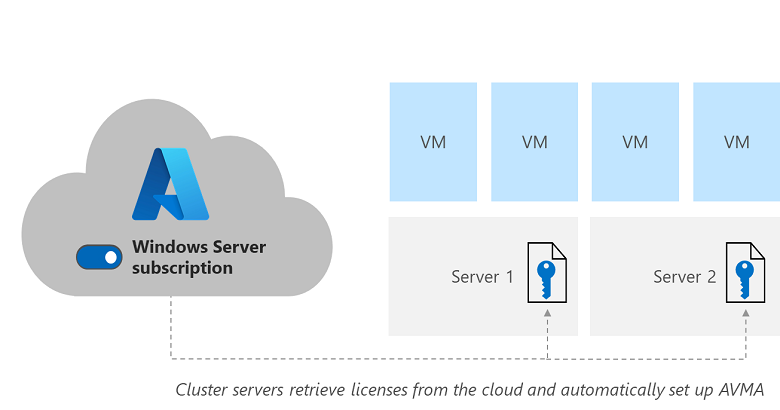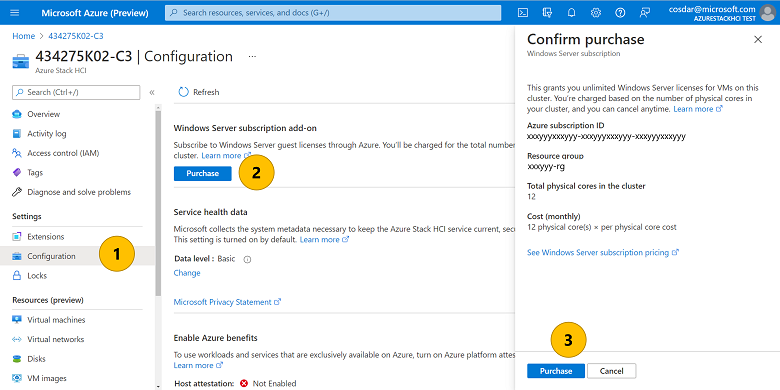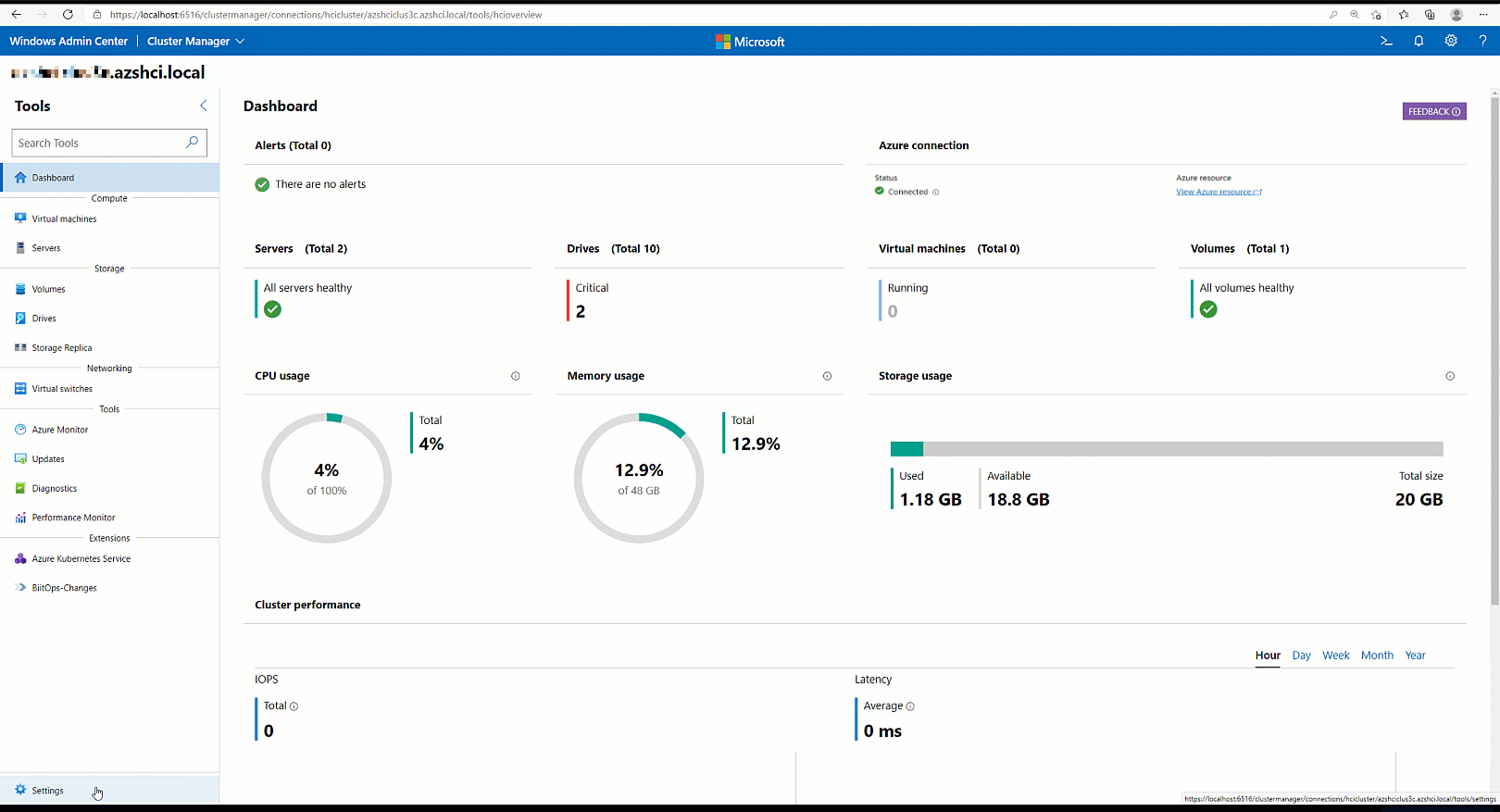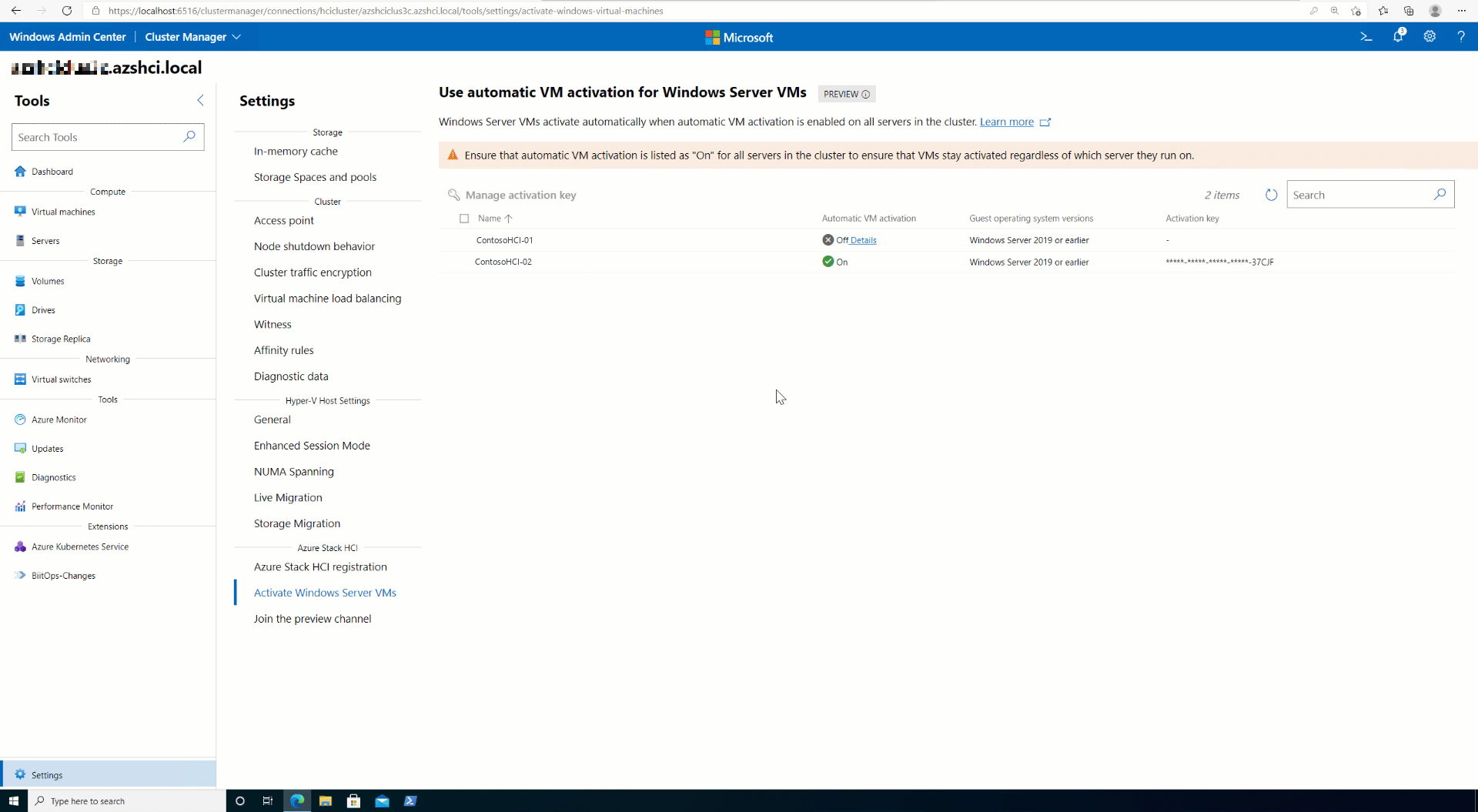License Windows Server VMs on Azure Stack HCI
Applies to: Azure Stack HCI, versions 22H2; Windows Server 2022, Windows Server 2019 Datacenter Edition and later
Windows Server virtual machines (VMs) must be licensed and activated before you can use them on Azure Stack HCI. You can use any existing Windows Server licenses and activation methods that you already have. Optionally, Azure Stack HCI offers new licensing models and tools to help simplify this process. This article describes general licensing concepts and the new options that are available on Azure Stack HCI.
Summary
The following figure shows the different Windows Server VM licensing options:
First, choose one of two options:
- Windows Server subscription: Subscribe to Windows Server guest licenses through Azure. Available for Azure Stack HCI only.
- Azure Hybrid Benefit (AHB): Use qualifying on-premises licenses to get Windows virtual machines (VMs) on Azure at a reduced cost.
For more information, see Compare options.
Next, activate your Windows Server VMs:
- If you're using Windows Server subscription, AVMA is automatically enabled on the host. You can immediately activate VMs against the cluster using generic AVMA client keys.
- If you're using AHB, you must use the corresponding keys associated with your license and apply them using your chosen activation method. One of the most convenient ways is to use Automatic VM Activation (AVMA).
- To use other methods to activate VMs, see Key Management Services (KMS) activation planning.
Compare options
Choose the deployment option that best suits your needs:
| Question | Windows Server subscription | Azure Hybrid Benefit (AHB) |
|---|---|---|
| What versions of WS VMs do you want to use? | Evergreen – all versions up to the latest version. | All versions up to the latest version - includes versions of Windows Server that are supported by Azure Stack HCI. Specifically, the benefit is extended to Azure Stack HCI version 22H2. |
| Does this option also allow me to use Windows Server: Azure edition? | Yes. | Need to have both Software Assurance (SA) and WS volume license keys. |
| How do I activate my WS VMs? | No host-side keys – AVMA is automatically enabled. After it's enabled, you can then apply the generic AVMA keys on the client side. | To activate this benefit, you must exchange your 1-core license of Software Assurance-enabled Windows Server Datacenter for 1-physical core of Azure Stack HCI. For detailed licensing requirements, see Azure Hybrid Benefit for Windows Server. |
| What are the CAL requirements? | No CAL required – included in WS subscription. | No CAL required – included in SA/WS subscription. |
| What is the pricing model? | Per physical core/per month pricing, purchased and billed through Azure (free trial within the first 60 days of registering your Azure Stack HCI). For details, see Pricing for Windows Server subscription. | This benefit waives the Azure Stack HCI host service fee and Windows Server guest subscription fee on your cluster. Other costs associated with Azure Stack HCI, such as Azure services, are billed as normal. For details about pricing with Azure Hybrid Benefit, see Azure Stack HCI pricing. |
Guest versions
The following table shows the guest operating systems that the different licensing methods can activate:
| Version | AHB Windows Server 2019 license | AHB Windows Server 2022 license | Windows Server subscription |
|---|---|---|---|
| Windows Server 2012/R2 | X | X | X |
| Windows Server 2016 | X | X | X |
| Windows Server 2019 | X | X | X |
| Windows Server 2022 | X | X | |
| Windows Server 2022: Azure Edition | Requires Software Assurance | Requires Software Assurance | X |
| Future editions (Evergreen) | X |
Activate Windows Server subscription
Windows Server subscription enables you to subscribe to Windows Server guest licensing on Azure Stack HCI through Azure. For the Windows Server subscription fees, see the Add-on workloads (optional) section in the Azure Stack HCI pricing page.
How does Windows Server subscription work?
When Windows Server subscription is purchased, Azure Stack HCI servers retrieve licenses from the cloud and automatically set up AVMA on the cluster. After setting up AVMA, you can then apply the generic AVMA keys on the client side.
Windows Server subscription prerequisites
An Azure Stack HCI cluster
- Install updates: Version 21H2, with at least the December 14, 2021 security update KB5008210 or later.
- Register Azure Stack HCI: All servers must be online and registered to Azure.
If using Windows Admin Center:
- Windows Admin Center (version 2103 or later) with the Cluster Manager extension (version 2.41.0 or later).
Enable Windows Server subscription
You can enable Windows Server subscription through different methods. Select one of the following tabs based on your preferred method.
In your Azure Stack HCI cluster resource page, navigate to the Configuration screen.
Under the feature Windows Server subscription add-on, select Purchase. In the context pane, select Purchase again to confirm.
When Windows Server subscription has been successfully purchased, you can start using Windows Server VMs on your cluster. Licenses take a few minutes to be applied on your cluster.
Troubleshoot subscription issues
Error: One or more servers in the cluster doesn't have the latest changes to this setting. We apply the changes as soon as the servers sync again.
Remediation: Your cluster doesn't have the latest status on Windows Server subscription - for example, you enrolled or canceled and therefore may not have retrieved the licenses to set up AVMA. In most cases, the next cloud sync will resolve this error. For faster resolution, you can sync manually. For more information, see Syncing Azure Stack HCI.
Activate VMs against a host server
Now that AVMA is enabled through Windows Server subscription, you can activate VMs against the host server by following the steps in Automatic Virtual Machine Activation in Windows Server.
Activate Azure Hybrid Benefit (AHB) through AVMA
You can use any existing method to activate VMs on Azure Stack HCI. Optionally, you can use AVMA, which enables activated host servers to automatically activate VMs running on them. For more information, see AVMA in Windows Server.
Benefits of AVMA
VM activation through host servers presents several benefits:
- Individual VMs don't have to be connected to the internet. Only licensed host servers with internet connectivity are required.
- License management is simplified. Instead of having to true-up key usage counts for individual VMs, you can activate any number of VMs with just a properly licensed server.
- AVMA acts as a proof-of-purchase mechanism. This capability helps to ensure that Windows products are used in accordance with product use rights and Microsoft software license terms.
AVMA prerequisites
Before you begin:
Get the required Windows Server Datacenter keys:
- Key editions: Windows Server 2019 Datacenter or later. For information about what guest versions your key activates, see Guest versions.
- Number of keys: One unique key for each host server you are activating, unless you have a valid volume license key.
- Consistency across cluster: All servers in a cluster need to use the same edition of keys, so that VMs stay activated regardless of which server they run on.
An Azure Stack HCI cluster (version 20H2 with the June 8, 2021 cumulative update or later).
Windows Admin Center (version 2103 or later).
The Cluster Manager extension for Windows Admin Center (version 1.523.0 or later).
Note
For VMs to stay activated regardless of which server they run on, AVMA must be set up for each server in the cluster.
Set up AVMA
You can set up AVMA through different methods. Select one of the following tabs based on your preferred method.
Use either Windows Admin Center or PowerShell to set up AVMA.
Troubleshoot AVMA using Windows Admin Center
If you receive the following AVMA error messages, try using the verification steps in this section to resolve them.
Error 1: "The key you entered didn't work"
This error might be due to one of the following issues:
- A key submitted to activate a server in the cluster was not accepted.
- A disruption of the activation process prevented a server in the cluster from being activated.
- A valid key hasn't been applied to a server that was added to the cluster.
To resolve such issues, in the Activate Windows Server VMs window, select the server with the warning, and then select Manage activation keys to enter a new key.
Error 2: "Some servers use keys for an older version of Windows Server"
All servers must use the same version of keys. Update the keys to the same version to ensure that the VMs stay activated regardless of which server they run on.
Error 3: "Server is down"
Your server is offline and can't be reached. Bring all servers online and then refresh the page.
Error 4: "Couldn't check the status on this server" or "To use this feature, install the latest update"
One or more of your servers isn't updated and doesn't have the required packages to set up AVMA. Ensure that your cluster is updated, and then refresh the page. For more information, see Update Azure Stack HCI clusters.
FAQs
This section provides answers to some frequently asked questions (FAQs) about licensing Windows Server.
Will my Windows Server Datacenter Azure Edition guests activate on Azure Stack HCI?
Yes, but you must use either Windows Server subscription-based AVMA, or else bring Windows Server Datacenter keys with Software Assurance. For AHB, you can use either:
Do I still need Windows Server CALs?
Yes, you still need Windows Server CALs for AHB, but not for Windows Server subscription.
Do I need to be connected to the internet?
You do need internet connectivity:
- To sync host servers to Azure at least once every 30 days, in order to maintain Azure Stack HCI 30-day connectivity requirements and to sync host licenses for AVMA.
- When purchasing or canceling Windows Server subscription.
You don't need internet connectivity:
- For VMs to activate via Windows Server subscription or AHB-based AVMA. For connectivity requirements for other forms of activation, see the Windows Server documentation.
When does Windows Server subscription start/end billing?
Windows Server subscription starts billing and activating Windows Server VMs immediately upon purchase. If you enable Windows Server subscription within the first 60 days of activating Azure Stack HCI, you automatically have a free trial during that period.
You can sign up or cancel your Windows Server subscription at any time. Upon cancellation, billing and activation via Azure stops immediately. Make sure you have an alternate form of licensing if you continue to run Windows Server VMs on your cluster.
I have a license for Windows Server, can I run Windows Server 2016 VMs on Azure Stack HCI?
Yes. Although you can't use Windows Server 2016 keys to set up AVMA on Azure Stack HCI, they can still be applied using other activation methods. For example, you can enter a Windows Server 2016 key into your Windows Server 2016 VM directly.
Where can I get AHB keys for AVMA?
To get a product key, choose from the following options:
- OEM provider: Find a Certificate of Authenticity (COA) key label on the outside of the OEM hardware. You can use this key once per server in the cluster.
- Volume Licensing Service Center (VLSC): From the VLSC, you can download a Multiple Activation Key (MAK) that you can reuse up to a predetermined number of allowed activations. For more information, see MAK keys.
- Retail channels: You can also find a retail key on a retail box label. You can only use this key once per server in the cluster. For more information, see Packaged Software.
I want to change an existing key. What happens to the previous key if the overwrite is successful/unsuccessful?
Once a product key is associated with a device, that association is permanent. Overwriting keys doesn't reduce the activation count for used keys. If you successfully apply another key, both keys would be considered to have been "used" once. If you unsuccessfully apply a key, your host server activation state remains unchanged and defaults to the last successfully added key.
I want to change to another key of a different version. Is it possible to switch keys between versions?
You can update to newer versions of keys, or replace existing keys with the same version, but you can't downgrade to a previous version.
What happens if I add or remove a new server?
You must add activation keys for each new server, so that the Windows Server VMs can be activated against the new server. Removing a server doesn't affect how AVMA is set up for the remaining servers in the cluster.
I previously purchased a Windows Server Software-Defined Datacenter (WSSD) solution with a Windows Server 2019 key. Can I use that key for Azure Stack HCI?
Yes, but you'll need to use keys for Windows Server 2022 or later, which will be available after the general availability of Windows Server 2022.






